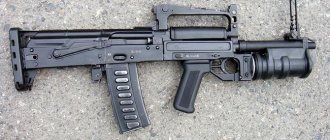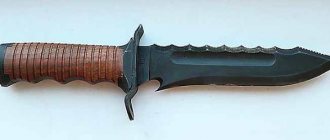Home » Interesting to know » Ax - another battle ax
Publication date: April 23, 2015 at 11:33 am
Ax - another battle ax
Hello, dear readers! Today I would like to continue the topic of “Battle axes” and describe to you about such an example from this series as an ax. Let's talk about its characteristics and functionality. And also about several varieties of axes, common in Asia and Europe.
Ax - battle ax
The ax is one of the varieties of the battle ax and is considered a chopping bladed weapon. It is characteristically different from other axes in that it has a crescent-shaped blade, sharpened along the convex part. It takes its roots from ancient times.
Ax - battle ax
The ax called “labrys,” common in Ancient Greece, had a symmetrical second blade, like a butterfly, instead of a butt. Historians write that weapons of the same shape were common among both the peoples of Asia and the Romans.
The ax was also known in many European countries and in Rus'. It was used in most cases by infantry to pull riders off their horses and pierce heavy armor. To do this, a strong and long spike, sometimes curved downwards, was located on the butt side of the axe.
Judging by the name, we can say that a poleaxe is an axe, only the shaft itself is slightly longer. But there is a difference - it's balance. Balancing the ax gives its owner good freedom of movement. An ax is used due to its weight, like a hammer or mace.
In most cases, the ax differs from axes in that it can be used to thrust, so the ax would have to have a feather pointed forward, like a halberd. In Asia, skilled martial artists preferred to wield a poleaxe rather than an axe, since in good hands the poleaxe is capable of a lot. Judging by its appearance, we can say that it is a hybrid between a spear and a sword.
Read on "E-KLAD": Battle axes: an excursion into history
Types of spearheads and axes in Rus' in the 9th-13th centuries.
Added Oct 23, 2022 to Treasure Hunting
Battle axes and spears in Rus'
The spear of the foot warrior was slightly longer than a man. It consisted of a durable shaft, onto which a socketed tip up to 50 cm long was mounted. Tips were made both all-steel and combined. In the second case, a steel plate was forged between ordinary iron. Thus, the cutting edges were self-sharpening. The shape of the tips varied, but mostly the elongated triangular one predominated. Such spears were used by warriors not for throwing, as many mistakenly assume, but in hand-to-hand combat. The shield was thrown behind the back, the spear was taken with both hands and the fighter, parrying the blows of the enemies, inflicted chopping and puncture wounds on them.
Darts called “sulitsa” were used for throwing. Their length did not exceed 150 cm, and the tip was often attached to the shaft not with a sleeve, but with a stem. Hunting darts had wider tips than combat darts, designed to pierce enemy shields and armor.
sulitsa
Sometimes during excavations, bay leaf-shaped tips weighing about a kilogram are discovered. Their length is about 30 cm and the sleeve is up to 5 cm in diameter. This is the so-called spear, with which the ancient Slavs went to fight a bear, and in the hands of a hero it turns into a formidable weapon.
Horse riders also had spears - cavalry pikes. Their length was about 3.5 meters, and the tip was a long tetrahedral rod.
Classification of spearheads in Rus' in the 9th-13th centuries.
I) A spear with a lanceolate-shaped feather, easily tapering at the neck and smoothly turning into a sleeve. The further north you go, the more lanceolate spears there are. In the 10th century in the South-Eastern Ladoga region they predominate among other forms. In Russian squad burials, lanceolate spears are one of the main types, found both in the north and in the south of the country (Vladimir, Gnezdov, Chernigov mounds)
II)Spear with a rhombic feather. The edge is visible on the blade. All examples of this type were found in the middle zone, mainly among Murom-Mordovian antiquities of the 9th-11th centuries. In general, diamond-shaped spears are not typical for Slavic weapons.
III) A spear with a relatively wide feather of an elongated triangular shape. Spears of this group are among the most popular and are found everywhere.
IV) A spear with an oblong-ovoid-shaped feather, rounded shoulders, turning into a low crown. The main finds were identified in northern Rus'. Particularly worth noting is the type (IV A), which has many mentions in chronicles and is called a spear, which served in ancient times as a military weapon, and later became a hunting weapon. Rogatina is apparently a Russian invention; nothing similar is known in other countries. It is interesting that in Polish the word “rogatina” is borrowed from Russian
V) A spear with a feather in the form of a tetrahedral rod and a funnel-shaped crown. These are the narrowest ancient Russian spears; they can be called peaks. The oldest peaks dating back to the 8th-9th centuries were found in the Kharkov region, in the middle Don region and in the northern Caucasus. The peaks penetrate into Western Europe hardly earlier than the 12th-13th centuries. In Scandinavia and Finland during the Viking Age they are very rare. From foreign analogies, English narrow faceted spears are known, approximately contemporary with Russian finds of the 12th-13th centuries. Thus, in the X-XI centuries. Rus' was one of the few European countries that used spears of this type, which were borrowed from the regions of the steppe Southeast, since pikes were the typical weapon of the Asian nomadic warrior.
VI) A spear with an elongated triangular feather and a petiole instead of a sleeve. Petiolate spears were found in burial complexes of the 10th-11th centuries. and almost all come from the areas where the Chud tribes were located (South-Eastern Ladoga region, western part of the Leningrad region, Suzdal Opolye, Murom region). In the composition of Russian weapons, stalked spears are random and after the 11th century, apparently, fall out of use. The reason for this is probably the weak and inconvenient connection between the shaft and the tip, which forced us to switch to a more reliable sleeve connection.
VII) A spear with a feather in the form of two spikes diverging to the sides. Most often, double-pronged spears (their name is harpoons) are found in Murom burial grounds. Double-barbed spears are primarily hunting weapons, and in this respect they are no different from double-barbed arrows. The tip device is designed to get stuck in the body of the animal.
Battle axes in Rus'
Axes as military weapons in Rus' are not mentioned very often in the literature. There is a widespread misconception that battle axes were used mainly by barbarians who treacherously attacked civilians. However, it is not. They were inconvenient for riders, but among foot soldiers they were present on a par with swords.
There are several main types of battle axes. Here are some of them: • Chekan - had a long narrow blade, allowing it to pierce armor • Ax - a wide ax blade, mounted on a long shaft • Bearded ax - a wide blade, as if pulled down and bent towards the shaft. On the butt it had extensions called “cheeks”. “Toes” were made on the back side. Thanks to these features, the shaft did not break when removing it from the tree if it got stuck.
Contrary to popular belief, the ax was most often used as a working tool, and the “bearded” ax was used as a combat ax. Later it became widespread in the Baltic countries, Scandinavia, the Czech Republic, and Poland, which indicates its Russian origin. In the thick of battle, it is much more convenient to swing a light, sharp weapon, hiding behind a shield.
On many of the axes found, there is a hole on the blades. There were many versions of his purpose. Today, archaeologists are inclined to believe that the hole was intended for attaching a cover to the blade, as well as for hanging the ax on a saddle or wall.
Most of all, battle axes in medieval Rus' became widespread in the northern regions, where wooded areas predominated. In the south, with its steppe expanses, where cavalry played a decisive role in battles, they are found much less frequently.
Classification of axes in Rus' X-XIII centuries.
I) The blade is triangular, narrow and elongated, sometimes slightly curved at the bottom. The jaws of the butt are triangular in shape, and the hammer attachment always produces a square in cross section. They were common in the 10th–13th centuries. It is this type that the coin, the most popular battle ax among warriors in Rus', belongs to. It is the coins that are usually found in squad burials. Judging by their exceptional numbers, these axes were not expensive imported weapons, but were made by local craftsmen.
II) Another version of coinage. Its blade is long, trapezoidal in shape, and on the back of the butt there is a narrow lamellar “beak”. This version of the ax is found only in burials dating from the 10th and first half of the 11th centuries. Similar models were discovered during excavations in Latvia, Poland, Sweden and Hungary.
III) A combat ax with a narrow blade, very common. Such models were found in burials of the 10th–11th centuries throughout Russia. A lot was extracted from the Vladimir mounds. But in the north of the country this type of ax is not particularly widespread. Considering the number of hatchets of this type found in Russia and other countries, and the time of their manufacture, we can conclude that this model was created by local craftsmen, and from here it migrated to neighboring states.
IV) A version of the ax with a carved, elongated butt and a wide triangular blade extended downwards. The upper edge of the blade is straight. Often the lower part of the blade had a truncated shape, this made it possible to carry the weapon on the shoulder, resting the blade against the back. Two notches on the cheeks provided the blade with reliable fixation on the butt. Archaeologists found these axes in both combat and working versions, in a ratio of almost 50/50. Some household axes were found complete with weapons and may have been used as a universal tool, suitable for both work and battle. The axes found date back to the 10th, 11th and 12th centuries. Often these weapons were the only ones that were discovered by military archaeologists, and this is not surprising. The exceptionally successful shape of the ax and a reliable, strong butt, secured with triangular jaws, made this weapon surprisingly effective. Russian craftsmen knew how to make battle axes practical and formidable weapons. This type of weapon was suitable for a strong vertical blow; the curved edge of the blade made it possible to deliver cutting blows - a property useful not only in battle, but also in everyday life. Such axes are also considered exclusively an invention: in Russia, similar finds date back to the 10th century, and foreign analogues were created no earlier than the 11th century, that is, 100 years later.
V) A type of ax with a significantly drawn down blade and a pronounced notch. The cheekbones have only one lower notch. Such axes were in use in the 10th and early 12th centuries. In the north of Rus', these particular guns were extremely popular; significantly more of them were discovered than other models. And this is quite logical, because Scandinavian culture gave a similar blade shape to the Russians. There were many battle axes of this type; they actively came into use three hundred years earlier.
VI)Differs from the model described above by its characteristic double cheeks. At first, these axes were used as combat axes (from the 10th to the 11th centuries). But their characteristics were significantly lower than those of the 4th type, and by the 12th century axes became predominantly working. They were usually not combat tools, but household tools, which is why the butt was attached so securely.
VII) Very similar to type 3, but its butt design is different. This is an outdated form of a heavy splitting axe, rarely used in combat conditions. Such instruments were popular as weapons in the 5th–9th centuries, later replaced by more advanced forms.
Characteristics of the ax
The ax consists of a shaft, a blade and a counterweight at the end of the shaft. The ax shaft consists of an ordinary stick, sometimes with a wrapping to prevent your hands from slipping on the shaft. The length of the shaft depends on the method of use: for infantry up to 2.5 meters, “combat halberd”; for cavalry 70 - 80 centimeters, “horse axes”; for boarding ships up to 3 meters, “boarding halberd”.
Battle ax
The warhead was inserted into the eye and secured to the shaft with nails or rivets. The blade of the ax has many types and shapes, but in most cases it looked like a month-shaped blade, not moving far away from the shaft itself.
Since, the further the blade moved away from the shaft, the more the balance of the ax was lost, and, in turn, the possibility of fencing techniques. And if one side is heavier than the other, such an ax will be very difficult to wield.
The use of “butterfly” axes showed that it was difficult to strike with such an ax; the ax itself was very heavy and upon impact there was a very large inertial force. There were also axes where the blade exceeded the shaft itself and served as a counterweight to itself.
Often the front part of the blade was sharpened so that it was possible to deliver piercing blows, although in several types of axes a kind of spike is used for this. Very often, between the blade and the spike or the blade and the shaft there is a gap, which is used to capture the opponent’s blade, but for this you need to be fluent in the fencing techniques of the axe.
On the opposite side of the blade, where the butt is located, some types of axes use a hook. It is used for various purposes, such as: grabbing the wall or side of a ship, throwing a rider off a horse, and much more.
The cutting part of the ax varies in length from 10 centimeters to a blade equal in length to a sword-shaped blade. At the bottom of the ax blade there is a protrusion, below the fastening point itself, it is called a scythe and is used for better fastening of the blade itself to the shaft.
The counterweight was a simple metal knob or spike that was used to push into the ground, but it could also be used to deliver a discreet blow. Without a counterweight, the ax would be very difficult to handle.
Ax functionality
Multifunctionality of the ax
The functionality of the ax allows you to use it as a spear, the difference between them is only in length, and of course the balance will not allow you to throw the ax like a spear. In a one-on-one fight, the ax has many advantages over other types of melee weapons.
An ax can be used to pull a warrior off a horse or to strike at the lower limbs unprotected by a shield. If, for example, spears were used in defense, axes and swords in attack, then axes were the golden mean between them. Although many armies used detachments of ax-bearers to protect the flanks, using pikemen in the center.
Read on "E-KLAD": Celtic ax - combat or ordinary hard worker
How did poleaxes appear and why are they called that?
First you need to figure out why Polex was called that way. This is a typically English name, which tells us that this weapon was invented on the territory of the British Isles. There is an English word "poleaxe", which clearly comes from "axe". In England, all war hammers with a long handle were called polaxes, regardless of their structure and shape.
Many researchers believe that the poleaxes became an English version of the Danish broadaxes, although if you compare these two types of weapons, they have nothing in common except that they are poleaxes. Most likely, weapons similar to poleaxes arose precisely to fight the Vikings and their two-handed axes. Only such weapons made it possible for ordinary Englishmen to resist the large Vikings, for whom war was the main craft. The spikes on the weapon made it possible to keep the northern butchers away, and it was almost impossible to cut the metal-bound shaft.
There is another hypothesis explaining the origin of the polex. Some historians believe that this weapon was a further milestone in the development of the conventional one-handed war hammer. Like, first he became two-handed, then he got a spear point, and then he added an ax.
It doesn’t matter how the Polex actually appeared, the important thing is that this weapon was able to combine the advantages of several types of weapons. The classic polex is an axe, a pike and a war hammer in “one bottle”.
Initially, it was believed that the polex was the traditional weapon of the knights of England. This conclusion was reached by scientists studying engravings and frescoes dating back to the era of the knights. But later studies studying the skeletons of soldiers who died on the battlefields proved that polexes were used en masse and were weapons of ordinary infantry in the period from the 14th to the 17th centuries. This is not a Wallachka, which was more of a household weapon; the polex was a purely military weapon, not adapted for peaceful life and everyday use.
Universal poleaxes were used on European battlefields until the advent and spread of firearms. After plate armor began to disappear, the need for poleaxes, which were still quite clumsy, also disappeared.
Several of the most common types of axes
Several of the most common types of axes
Since axes were common in many countries of Europe and Asia, in each country the battle ax looked different and was used, depending on the shape of the blade, for different purposes. But still, let’s try to deal with each of them separately.
Halberd
Several types of halberds
A halberd is a bladed pole weapon with a combined tip. The tip is a needle-shaped spear point up to one meter long and can be either round or faceted. The tip of the halberd itself sometimes had a hook. There is a small ax blade on one side, and a pointed butt on the other.
The advantages of the halberd were demonstrated to Europe in the 14th century, thanks to Italian and Swiss mercenaries, who showed all the advantages of this ax in battle against knightly cavalry. In Flanders, the halberd was given the name “godenak”.
The halberd was in service with many European countries from the 13th to the 17th centuries, but it became most widespread in the 15th and 16th centuries as the most effective weapon against armored cavalry. The shaft of the halberd reached 2 - 2.5 meters and the weight was from 2.5 to 5.5 kilograms.
The halberds differed only in the shape and size of the axe. The blade of the ax could be: flat or crescent, narrow or wide, concave or convex, in the form of an ax or mint, number of hooks.
But there were also halberds that did not have a spear point and looked like an ordinary ax on a long shaft. By the 15th century, the halberd had finally formed and looked like: a narrow hatchet on one side, and on the other, a curved and pointed butt, a large needle-like point on one side of the shaft, and on the other side, a small knob or a small point for better sticking into the ground .
In battle, there was no armor that a halberd could not penetrate with its tip; crushing and slashing blows were delivered with a hatchet or butt; a rider was pulled off a horse with a hook, or ships were pulled together during boarding. Boarding halberds were also equipped with a large hook for better grip and an elongated shaft (up to 3 meters).
Brodex or broad-bladed ax
Brodex or broad-bladed ax
The name of the ax comes from the English word “broad axe”, meaning a wide axe. The broad-bladed ax has a wide trapezoidal blade. Brodexes became most widespread in the 10th-11th centuries, in the Baltic states and Scandinavia.
Judging by archaeological finds, there were practically none of them on the territory of Rus'. Brodex had a characteristic rounded blade blade. Brodex blades can be divided into types with one-sided and two-sided sharpening. Double-sided broadaxes were battle axes, but they were very heavy and inconvenient in terms of striking.
But later they found a use for executions that existed in the modern era; executioners cut off heads with such axes. Broadaxes with one-sided sharpening, on the contrary, were not used for combat, but were used in agriculture. For example, due to its large flat surface, it was easy for them to process the surface of a fallen tree, beam or beam.
Berdysh
Battle ax - berdysh
Berdysh is a bladed weapon, like an ax - a poleaxe. The origin of the ax has not been figured out, and to this day, some believe that it came from the French word “bardiche”, others that from the Polish “berdysz”.
The blade is curved, resembling a crescent moon in appearance, mounted on a long shaft reaching up to 180 centimeters. They also said “ratovishche” on the shaft. The blunt part of the ax blade had a hole for mounting on the blade, and as in an ordinary ax, it is called the butt, the opposite edge of the blade is called the blunt, and the end of the blade drawn down is called the braid.
The ratovishche was attached to the metal, mounted on the butt and nailed with nails or rivets, and the braid was tied with a strap. To nail the shaft to the butt, holes were made in it; their number could reach up to 7.
The braid was also first nailed down with several nails, and a rope or strap was also wound on top. In some cases, a thin strap on each turn was secured with a small nail. On the lower part of the shaft, a metal tip, the so-called “podtok”, was mounted, designed to better rest the reed on the ground.
The underflow was used when firing muskets, but also during parade formation. There are reeds in which small holes were made on the blade itself throughout the entire blade and rings were inserted into them. Thanks to this experiment, the reeds that were used by the cavalry appeared. The axes of the mounted archers were much smaller than the axes of the foot soldiers.
On the ratovishche there were two metal rings for the shoulder strap, so that it would be more convenient for the rider to use the reed. Riders began to use berdyshes less and less, as with the lighter armor, swords, and later sabers, became relevant.
Lochaber ax
Lochaber ax
Lochaberaxt or Lochaber ax translated from English means “Lochaber axe” and takes its roots from the name of the territory in Scotland called Lochaber. Externally, lohaberakst is very similar to berdysh.
The ax consists of an iron blade with two eyes into which the shaft itself is inserted, about one and a half meters long. The length of the blade itself reached 50 centimeters and had both a flat and wavy surface.
The upper end of the ax was in the shape of a crescent and was sharpened so that piercing blows could be delivered. On the eyes there could be a hook for pulling soldiers from the cavalry. The Lochaber ax was used by both cavalry and infantry and was a very versatile and effective battle axe.
Studying history, it can be assumed that the lohaberaxt, due to its functionality, was modernized into a halberd around the 15th century. But in Scotland they were relevant until the 18th century.
Sakravor
Sakravor
Sakravor, translated from Armenian “Սակրավոր” , comes from the word sakur, meaning axe. In the ancient Armenian army, warriors were mainly armed with an ax. From the name of the ax came the very name of the warriors - sakravor.
But since the warriors were very functional, their equipment also included other axes and military trench shovels. The Sakravors were engaged in laying roads, cutting down forests, building bridges, setting up military camps, trenches, haravands “խարավանդ” and much more.
It was also the responsibility of the sakravors to monitor the “gumak” - a convoy of horses and oxen transporting ammunition, food, and camp supplies. Nowadays you can hear in the Armenian army that sappers are referred to as sakravor. From which it follows that back in those days, the first multifunctional sappers appeared.
Scandinavian ax
Scandinavian ax
The Scandinavian ax is a medieval pole weapon. The Scandinavian ax differed from most axes in that it had a wide blade that symmetrically diverged in different directions. The ax was very thin, with side cheeks placed on it.
The thickness of the blade itself is about 2 millimeters, having a sleeve at the end; the width of the sleeve was 2.5 centimeters and the length was 3.5 centimeters. The blade blade was also large, its width was 17 - 18 centimeters, and its length was also 17 - 18 centimeters.
What you can understand is that it was not a square, since the blade diverged symmetrically in different directions. The weight of the ax without the shaft was about 450 grams, and the shaft reached a length of up to 120 centimeters. The ax takes its roots from its name - Scandinavia.
Thanks to their Norman influence, the Scandinavians introduced the ax to Europe in the 10th - 11th centuries; in Rus', such axes appeared only in the second half of the 10th century, and full-scale use began only in the 11th century. If in Rus' in the 12th - 13th centuries, axes began to lose their popularity, then in Europe, on the contrary, they are used very widely.
Over the course of the 12th - 13th centuries, axes underwent all sorts of modifications, such as: a spike was added, like a halberd, and the length of the shaft itself increased. One of these modifications will be the Polex . At the same time, an unmodified version of the ax is also used: as proof, in Ireland and Scotland they were used until the 16th century.
Polex
Battle ax - polex
The polex is a modified Scandinavian ax and is considered a European polearm. In the 15th - 16th centuries, the polex became one of the most widely used bladed weapons for foot soldiers. Like all axes, the polex was also divided into a shaft, up to two meters long, and a metal blade.
There was a needle-like spike at the top of the blade of the polex; on some axes, such a spike was also located at the bottom of the shaft. On the shaft itself there were iron strips of “splints”, descending on both sides of the blade head to the bottom and used to protect the blade from being cut.
There were polexes that had protection for the hands; such protection was called “rondel”. But the most important difference in the Polex was that all parts of the blade were assembled on bolts or pins; it was possible to replace a failed part with a new one. Because of this, it was very popular, since halberds at that time were solidly forged.
Siege knife
Siege knife
The siege knife is a polearm bladed weapon. Its purpose was to chop and stab. It looked similar to both a halberd and a glaive, but had a large shaft, about 3 meters.
The wedge-shaped tip had a wide cutting surface on one side and a large hook on the other, designed for clinging to fortress walls and using a knife to climb the same walls. It was used mainly in Germany and was relevant until the 18th century.
Guizarma
Battle ax - guizarma
Translated from Italian “guisarme” means guisarma, guisarda, guisarma . It is very similar to a halberd with a long narrow, slightly curved tip, the blade of which is straight, with a branch pointed at the end. The first branch is long and straight, and the other branch is a slightly curved thorn.
The spike and the blade are placed at a considerable distance from each other; from the appearance of the guizarama, one can say that its ancestors were ordinary agricultural forks. The Gwizarama is the only European ax designed primarily for grappling strikes.
Chopping blows with an ax were used primarily against horses, cutting their tendons, but it was also possible to pull off the rider himself. Such specific weapons appeared in the 11th century, but the final result was formed only at the end of the 14th century.
Features of Polex
In general, the classification of combined weapons of this type in Europe is incredibly complex. If halberds, pikes and reeds can still be definitely classified into a specific category, then all sorts of glaives and half-axes are very difficult to classify, since they have features inherent in different classes. This confusion is especially clearly expressed in the polex - a unique combined weapon that combines the advantages of an ax, a war hammer and a pike.
In general, medieval gunsmiths did not bother at all with the fact that they would be left with a bunch of all kinds of strange weapons that would be very difficult to classify. They simply tried to create the most effective weapon, capable of giving simple infantry an effective weapon against chivalry, which, with its armor, felt as invulnerable on the battlefield as modern tanks against infantry.
The appearance and improvement of armor has always provoked the emergence of new types of weapons specifically designed to penetrate the armor itself. Take the same coin - this highly effective weapon was designed specifically to pierce iron helmets. But unlike the coin, which was a horseman’s weapon, the polex was designed specifically for infantry.
In the XIV-XV centuries, combat armor was seriously modified. Classic weapons became ineffective, since it was difficult to penetrate full armor. It is clear that the same ax would cut through armor if it was possible to deliver a clear and focused blow to a certain point, but the fact is that the knights also did not stand still, and they wielded weapons several times better than ordinary infantry. Therefore, allowing a knight to approach you was like death for ordinary infantry. There are historical documents proving that an experienced knight easily defeated about five ordinary infantrymen, and if they were militias, then ten people were more than he could handle.
The appearance of specific weapons, such as crossbows, halberds and poleaxes, immediately forced the knights to respect ordinary infantrymen. The crossbow was especially unpleasant, as it could pierce even high-quality armor. Roughly speaking, even a simple militiaman with a crossbow could count on a chance of defeating a knight. And poleaxes were an ideal weapon against knights. Not only could armor be easily tested with their help, but thanks to the hammer on the butt, experienced warriors could simply stun knights and take them prisoner, and this could result in double benefit. Not only did the winner receive weapons, armor and all the knight’s property, but he could also demand a ransom for the knight’s life from his relatives. Considering that many knights were rich and noble, the ransom amount could provide for a person for the rest of his life.











